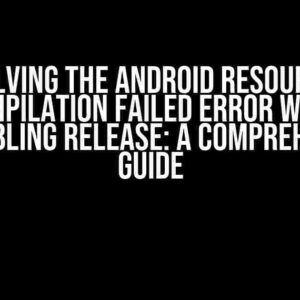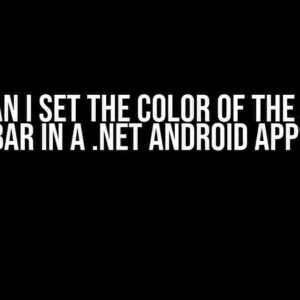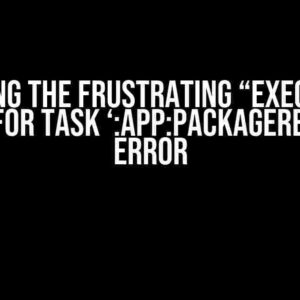Are you tired of struggling to extract valuable information from TCP connections in your Android Java application? Do you want to unlock the secrets of network communication and take your app to the next level? Look no further! In this comprehensive guide, we’ll dive into the world of Android Java and explore the steps to get payload from a TCP connection.
What is a TCP Connection?
Before we dive into the nitty-gritty of getting payload from a TCP connection, let’s take a step back and understand what a TCP connection is. TCP (Transmission Control Protocol) is a transport-layer protocol that ensures reliable communication between devices over IP networks. When a device initiates a TCP connection, it establishes a connection with the server, and data is exchanged between the two endpoints.
Why Do We Need to Get Payload from a TCP Connection?
In many scenarios, Android apps need to communicate with servers or other devices over TCP connections to exchange data. For instance, a chat app might use a TCP connection to send and receive messages between users. In such cases, it’s essential to extract the payload from the TCP connection to process and utilize the received data.
Setting Up the Environment
Before we start coding, ensure you have the following setup:
- Android Studio or your preferred IDE
- JDK 8 or higher installed
- Android SDK 23 or higher
Creating a TCP Connection in Android Java
To establish a TCP connection in Android Java, we’ll use the Socket class. Create a new Java class in your Android project and add the following code:
import java.net.Socket;
public class TcpConnection {
private Socket socket;
public TcpConnection(String hostname, int port) throws IOException {
socket = new Socket(hostname, port);
}
public void connect() throws IOException {
socket.connect();
}
public void close() throws IOException {
socket.close();
}
}
In this example, we create a TcpConnection class that takes a hostname and port number as parameters. The connect() method establishes the TCP connection, and the close() method closes the connection when we’re done.
Getting Payload from a TCP Connection
Now that we have a TCP connection established, let’s dive into the process of getting the payload from the connection. We’ll use the InputStream and OutputStream classes to read and write data to the socket.
import java.io.InputStream;
import java.io.OutputStream;
public class TcpConnection {
// ...
public byte[] getPayload() throws IOException {
InputStream inputStream = socket.getInputStream();
OutputStream outputStream = socket.getOutputStream();
// Send a request to the server (optional)
outputStream.write("GET /payload".getBytes());
outputStream.flush();
// Read the response from the server
byte[] buffer = new byte[1024];
int bytesRead;
ByteArrayOutputStream byteArrayOutputStream = new ByteArrayOutputStream();
while ((bytesRead = inputStream.read(buffer)) != -1) {
byteArrayOutputStream.write(buffer, 0, bytesRead);
}
return byteArrayOutputStream.toByteArray();
}
}
In this example, we add a new method getPayload() to the TcpConnection class. This method reads data from the input stream and writes it to a byte array. If you need to send a request to the server to initiate the payload response, you can do so using the output stream. Finally, we return the payload as a byte array.
Handling Errors and Exceptions
When working with TCP connections, it’s essential to handle errors and exceptions that may occur. Here are some common scenarios to consider:
| Error/Exception | Description | Handling |
|---|---|---|
| IOException | Occurs when there’s an I/O error during socket operations | Use try-catch blocks to handle IOExceptions and close the socket when an error occurs |
| SocketTimeoutException | Occurs when a socket operation times out | Use try-catch blocks to handle SocketTimeoutExceptions and retry the operation or close the socket |
| UnknownHostException | Occurs when the hostname or IP address is unknown | Use try-catch blocks to handle UnknownHostException and prompt the user to enter a valid hostname or IP address |
Best Practices for Working with TCP Connections in Android Java
To ensure efficient and reliable communication over TCP connections in your Android Java app, follow these best practices:
- Use timeouts to prevent socket operations from blocking indefinitely
- Handle errors and exceptions properly to prevent app crashes and data loss
- Use buffered streams to improve performance and reduce memory usage
- Implement connection pooling or reuse sockets to reduce overhead and improve performance
- Use encryption (e.g., SSL/TLS) to secure data transmission over TCP connections
Conclusion
In this comprehensive guide, we’ve explored the world of Android Java and learned how to get payload from a TCP connection. By following the steps and best practices outlined in this article, you’ll be able to establish reliable and efficient communication between your Android app and servers or other devices over TCP connections. Remember to handle errors and exceptions properly, and don’t forget to implement encryption to secure your data transmission.
Now, go ahead and unleash the power of Android Java in your app!
Frequently Asked Question
Get ready to dive into the world of Android Java and TCP connections! Here are some frequently asked questions to help you navigate through the process of getting payload from a TCP connection.
What is a TCP connection, and how does it relate to Android Java?
A TCP (Transmission Control Protocol) connection is a type of network communication protocol that allows devices to exchange data in a reliable and error-checked manner. In Android Java, you can use TCP connections to establish communication between your app and a server or another device. You can send and receive data, including payloads, using TCP sockets in your Android app.
How do I establish a TCP connection in Android Java?
To establish a TCP connection in Android Java, you’ll need to create a Socket object and connect it to a remote server or device using the IP address and port number. You can use the java.net.Socket class to create a socket and the Socket.connect() method to establish the connection.
What is a payload in the context of TCP connections?
In the context of TCP connections, a payload refers to the actual data being sent or received over the connection. This can include anything from a simple text message to a complex data structure, such as an image or a JSON object. The payload is the part of the data that is of interest to the application, excluding any additional headers or metadata.
How do I read the payload from a TCP connection in Android Java?
To read the payload from a TCP connection in Android Java, you’ll need to use the InputStream object associated with the Socket. You can use the read() method to read the incoming data into a byte array or a buffer, and then process the payload as needed.
What are some common challenges when working with TCP connections and payloads in Android Java?
Some common challenges when working with TCP connections and payloads in Android Java include handling connection timeouts, managing socket exceptions, and parsing the payload data correctly. You may also need to consider issues such as data serialization, encryption, and error handling to ensure reliable and secure data transfer.





